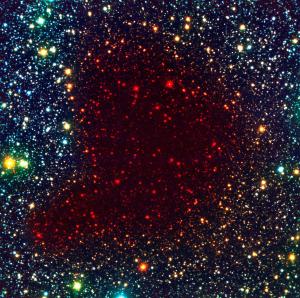Post
Bok Globules
30 August 2013
Yesterday I talked about how gas and dust between us and the stars can cause a reddening effect due to Rayleigh scattering. Normally this isn’t a large effect, but there are examples where this reddening effect can be significant. One such example is known as a Bok globule, seen below.
Bok globules are small, dense clouds of gas and dust, typically only about a light year across. They are thought to be dust clouds undergoing the early stages of gravitational collapse, on their way to becoming a stellar nursery. Since they are in the early stages of gravitational collapse, they haven’t formed any protostars to start generating heat. So they tend to be very cold as well as dense, meaning they don’t emit much light on their own.
Most of the time they appear dark blobs illuminated by background stars or nebulae. But in cases where light does get through, the starlight is reddened by Rayleigh scattering and absorption. You can see that effect in the image below, though in the image the effect is exaggerated with a bit of false coloring.
 ESO
ESOSince Bok globules are small, and are not gravitationally bound to other objects, they move freely through the galaxy. This means they can pass in front of more distant stars, causing them to dim and redden. For this reason, Bok globules have been proposed as an answer to one of the strange mysteries in ancient astronomy, known as the Red Sirius mystery.
Ptolemy was a second-century astronomer who wrote an authoritative book on astronomy known as the Almagest. In this book Ptolemy lists six bright red stars (Betelgeuse, Antares, Aldebaran, Arcturus, Pollux, and Sirius). Of these, the first five are decidedly red (or in the case of Pollux, red-ish). But Sirius is bluish white. So why call it red?
You might be tempted to write Ptolemy’s observation off as poor observation, but the guy was a high-calibre astronomer. There is also the fact that other prominent scholars of the time (such as Pliny the elder) also described Sirius as red.
Given what we know about stellar evolution in general, and Sirius in particular, we know that Sirius was not in a red giant stage nearly 2000 years ago. Nor was its white dwarf companion Sirius B. So either Sirius wasn’t red, and Ptolemy was incorrect in his assertion (or misquoted in subsequent manuscript copies), or something must have caused Sirius to appear red.
This is where Bok globules come in. One proposal to the Red Sirius mystery is that a Bok globule passed in between us and Sirius, making the star appear red for a few hundred years. The downside of this solution is that it would also make Sirus appear much dimmer, and even when Sirius is described as red, it is always also described as bright.
Most astronomers don’t give a lot of credence to the idea that Sirius was actually red at the time of Ptolemy. While other scholars can be seen to support his description, their specific writings can be a bit fuzzy in their interpretation. Then there is the fact that Chinese astronomers of that period (consummate observers in their own right) consistently describe Sirius as bright and white, and make no mention of any dimming or reddening.
But these small clouds have enough mysteries to hold our attention. We’re not entirely sure how they’ve gotten so dense given their size, then there is the fact that they are one of the coldest types of objects in the galaxy, and their temperature and density means that some interesting near-vacuum chemistry is going on.
Plus, Bok globules is just fun to say.